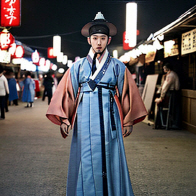Hanbok is a traditional Korean costume that was popular during the Joseon Dynasty.
Hanbok has a wide variety of shapes, materials, colors, and patterns. Hanbok can be largely divided into men's and women's hanbok. Men's Hanbok consists of pants, jeogori, vest, gown, and gat. Women's hanbok consists of skirts, jeogori, outerwear, and accessories that are worn over jeogori. Hanbok is made of various materials such as cotton, hemp, ramie, silk, and clothes. The colors of Hanbok were mainly bright and colorful, such as white, black, navy, green, yellow, and red. Hanbok's patterns include flowers, trees, animals, and other patterns. Hanbok is a costume that represents Korean traditional culture. Hanbok is a clothing that shows the identity and style of Koreans. Hanbok plays an important role in inheriting and developing Korean traditional culture.Types of Hanbok
Men's Hanbok: consists of pants, jeogori, vest, gown, and gat.
Women's Hanbok: It consists of a skirt, jeogori, outerwear, and accessories that are worn over the jeogori.
the form of hanbok
Pants: The bottoms of Hanbok. Pants are mainly made of various materials such as cotton, hemp, ramie, silk, and clothes.
Jeogori: It's a hanbok top. Jeogori is mainly made of various materials such as cotton, hemp, ramie, silk, and clothes.
Vest: It's a hanbok dress. Vests are mainly made of various materials such as cotton, hemp, ramie, silk, and clothes.
[Voiceover] The outer garment of Hanbok. Durumagi is mainly made of various materials such as cotton, hemp, ramie, silk, and clothes.
God: The headdress of Hanbok. Gat is mainly made of various materials such as cotton, hemp, ramie, silk, and clothes.
Skirt: It's the bottom of Hanbok. Skirts are mainly made of various materials such as cotton, hemp, ramie, silk, and clothes.
Outerwear: An outer garment of hanbok. Outer clothing is mainly made of various materials such as cotton, hemp, ramie, silk, and clothes.
the color of hanbok
White: indicates innocence, cleanliness, innocence.
Black: indicates moderation, frugality, prudence.
Navy: It represents wisdom, trust, security.
Green: represents vitality, hope, growth.
Yellow: indicates the color of the emperor, the color of the aristocracy, wealth.
Red: indicates passion, love, courage.
a pattern of hanbok
Flowers: represent beauty, purity, love.
Trees: represent vitality, hope, growth.
Animals: represent courage, strength, wisdom.
Patterns: Indicate decoration, aesthetic, and style.
Hanbok is a costume that represents Korean traditional culture. Hanbok is a clothing that shows the identity and style of Koreans. Hanbok plays an important role in inheriting and developing Korean traditional culture.





